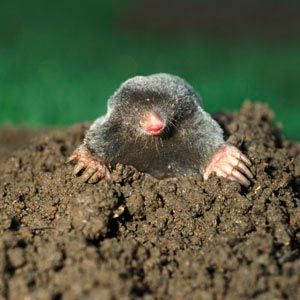 |
| Photo from www.moleremovalnashville.com |
For those that are fortunate enough to not know a lot about moles, they are not rodents and do not have characteristic rodent features such as large, sharp front teeth. Instead they have sharp, pointed teeth used for catching and eating grubs and earthworms, and its most remarkable features is its adaptations for life underground. It has greatly enlarged paddle-like front feet and enlarged toenails uniquely adapted for digging. Mole fur is short, soft, and velvet. Its feet, toenails and fur allow moles to literally swim forward and backward through the soil. Other adaptations for this life include a cylindrical body, a long, tapered snout, and eyes and ears so tiny they almost appear to be missing. The hind legs are very small, enabling the mole to turn with ease in a narrow passage. Fully grown moles measure 4 to 7 1/2 inches long complete with a very short tail. Fur color varies from black to brownish to grayish with silver highlights. It is the only animal to create surface tunnels and it’s anything but cute.
The first step in controlling moles is to actually determine if a mole is the culprit. Because moles are insectivores, they do not routinely eat garden seeds and bulbs, although they are often blamed. The real culprits are probably voles, white-footed mice, or house mice. If your garden has runways in it, the moles are looking for insects and earthworms.
The mole's greatest crime is the nuisance it creates in lawns and gardens. If you have this problem, take control measures. However, no one said mole control was easy. There are no known short cuts or magic potions to alleviate moles problems. However, the first thing you can do to try to get rid of moles is to get rid of their food source. Grub control should be your first line of defense. University of Kentucky Entomologists Michael F. Potter and Daniel A. Potter suggest using insecticides such as Acelepryn, Merit, GrubEx or Meridian.
Three other options that you have for mole control is trapping, fumigation and repellents. Of these three, trapping is the most effective because moles are solitary and have a high energy requirement that dictates a large feeding territory. Thus, mole densities are not as great as you might imagine. A single lawn may have only one or two moles, which means the offending animals can be removed and the problem solved. In addition, mole reproduction is so low that areas are not repopulated quickly.
The extent to which fumigants are effective depends on a variety of factors. This method is recommended only if the entire burrow system can be located and fumigated. This usually requires a neighbor's cooperation since a burrow system is typically found over three to four lawns. Fumigation is rarely effective if the soil is porous or dry, the fumigant is not correctly placed, the complete burrow system is not treated, or there are numerous shallow feeding tunnels. Never use a fumigant in a manner inconsistent with its labeling.
There is some new evidence that mole repellents containing the active ingredient castor oil are effective in repelling moles from lawns. These repellents are available under a wide variety of trade names. You should understand that these repellents do not actually kill the offending animal and, if suitable habitat remains, the moles will return. Be sure to follow the manufacturer's label closely.
Some other important mole facts to keep in mind are:
• Trapping is the only effective control method.
• Locate active travel tunnels.
• There are fewer moles in your yard than you think—two or three moles per acre, at most.
• Moles have a low reproductive rate; removing a few moles has a great impact on the population.
• Be patient and persistent; keep moving the trap until you are successful.
• Do not put chewing gum, chemicals, broken glass, or other objects in the burrows.
For more information on mole control, contact the McLean County Cooperative Extension Service at (270)273-3690. Educational programs of the University of Kentucky Cooperative Extension Service serve all people regardless of race, color, age, sex, religion, disability or national origin.
No comments:
Post a Comment